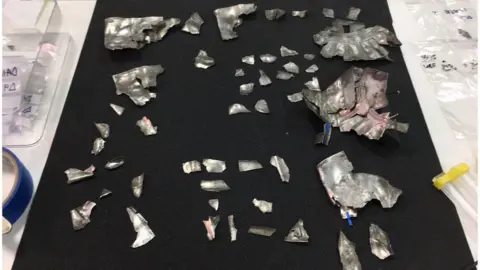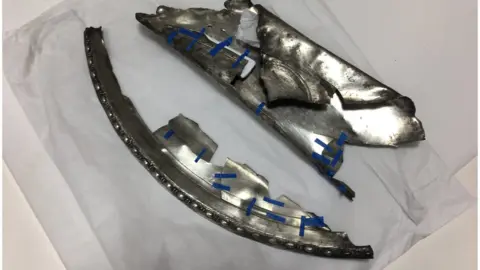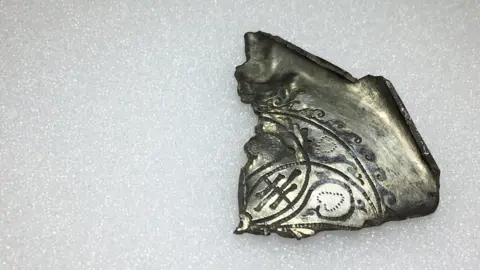'Significant' Roman silver hoard found in Fife by teenager
A hoard of Roman silver discovered by a teenage metal detectorist in his "first proper find" is to go on display in Scotland.
David Hall, from Livingston who is now 16, found the hacksilver in Fife when he was aged 14, in 2014.
The silver was believed to have been used by Roman soldiers to bribe Picts while passing through Scotland.
David said he did not initially realise the importance of the find and is excited to see how it now looks.
The Dairsie hoard dates to the late 3rd century AD and is the earliest hacksilver from anywhere beyond the frontiers of the Roman Empire.
The find has been hailed as "internationally significant" and will go on show for the first time in a new exhibition at the National Museum of Scotland in October.
David told BBC Scotland he first became interested in metal detecting after watching an American TV programme. He then saved up and bought a "low-end" detector.

He had only been using it for a few months when he came across the silver.
"It was quite a boring day," he said. "I was at a rally with 103 metal detectorists and we were looking in three fields and nothing had come up.
"All of a sudden I found a few bits of silver and I showed it to a friend who said it was Roman and after that we found another 200 pieces on the first day."
Hacksilver consists of silver objects hacked into pieces to make raw bullion.
Archaeologists think the silver came to Fife as a gift or payment from the Roman world.
The Romans could not just rely on the strength of their army - they also used diplomatic efforts to secure the empire's borders by buying off surrounding tribes.
As well as being hacked-up by the Romans, the hoard had been shattered by ploughing.

Curators have undertaken a daunting jigsaw puzzle, reconstructing four Roman vessels from more than 300 fragments, as well as examining how they had been cut into packages of bullion.
David said: "This was really my first proper find.
"I didn't realise how important it was at first, but it's been really exciting to be able to come and see what National Museums' curators and conservators have been able to do to clean it up and to examine it to work out what it is.
"It looks really different now. It's great to have unearthed a piece of history and I'm looking forward to seeing it on display at the museum."


Dr Fraser Hunter, principal curator at National Museums Scotland said: "New archaeological evidence is rewriting our understanding of Roman frontier politics, and silver was a key part of this.
"It's a fascinatingly complex picture that shows interaction and realpolitik, with the Romans changing their approach to deal with different emerging problems, and local tribes taking advantage of Roman 'gifts'. The Dairsie hoard is internationally significant.
"It's the earliest evidence for a new phase of Roman policy in dealing with troublesome tribes, using bribes of silver bullion in the form of hacked silver vessels.
"It's been great to show David Hall, the finder, the next steps in translating a find like this from the field, through the laboratories and on to public display."
The exhibition, Scotland's Early Silver, will show for the first time how silver, not gold, became the most important precious metal in Scotland over the course of the first millennium AD.
New research and recent archaeological discoveries will chart the first thousand years of silver in Scotland.


